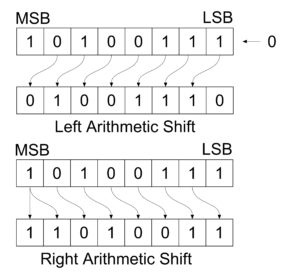Difference Between Arithmetic shift and Logical shift in Tabular Form
| SNO. | Arithmetic shift | Logical shift |
| 1. | An arithmetic shift via micro operation that shifts a signed binary number to the left and right. | A logical shift is one that transforms through the serial input. |
| 2. | An arithmetic shift left multiplies assigned binary number by. An arithmetic shift right divides number by 2. | The symbols strand and for logical shift left and logical shift right Micro-operations. |
| 3. | For example : Arithmetic Shift Arithmetic Shiftan micro operations that specify a 1-bit shift to left of content of register R1 and 1-bit shift to right of content of register R2. | For example : Logical Shift Logical ShiftThe left most bit is a register that holds sign bit and remaining bits and remaining bits hold the number. |
| 4. | The register symbol must be same on both sides of the arrow. | It does not follow the conditions as followed by arithmetic shift micro operations. |
| 5. | The bit transferred to the end position through serial input is assumed to be 0 during a logical shift. | The bit is not tranferred to the end position through serial input, since it follow difference arithmetic logic. |
- Arithmetic shift preserve sign bit, whereas Logical shift can not preserve sign bit.
- Arithmetic shift perform multiplication and division operation, whereas Logical shift perform only multiplication operation.
- Arithmetic shift is used for signed interpretation, whereas Logical shift is used for unsigned interpretation.
Point Reference Link
(Visited 37,102 times, 1 visits today)
Written by:

